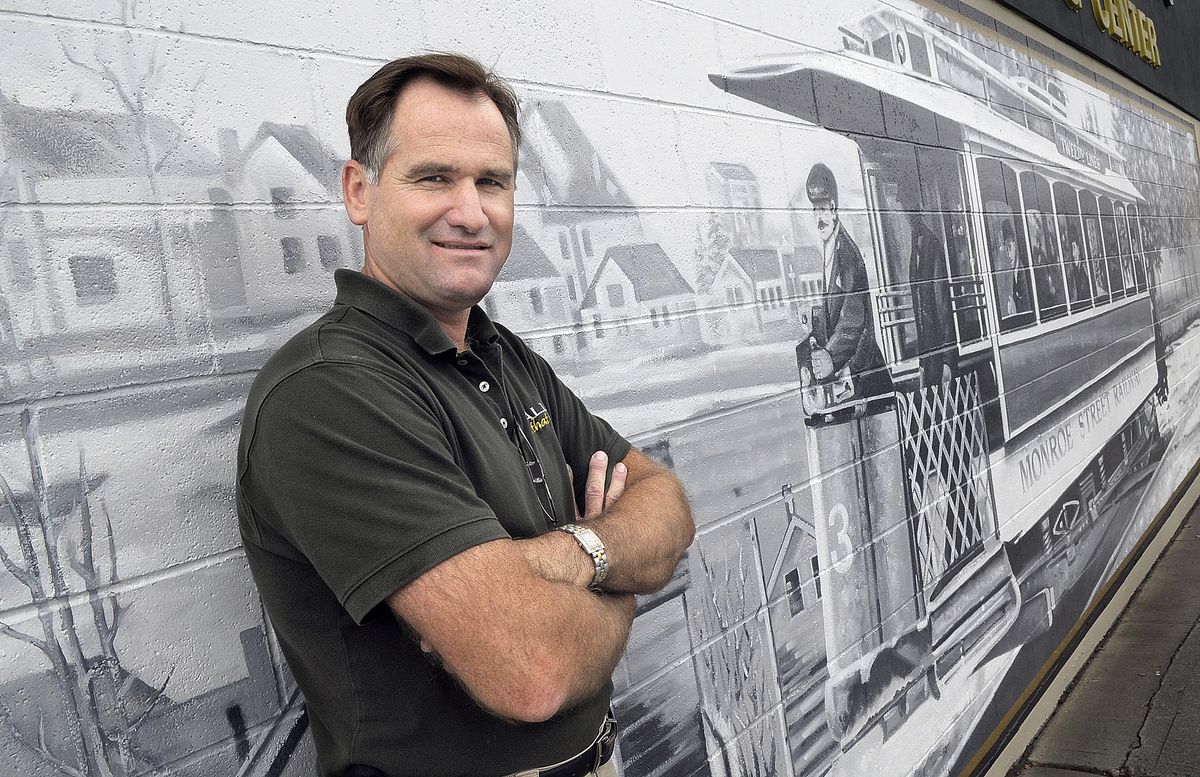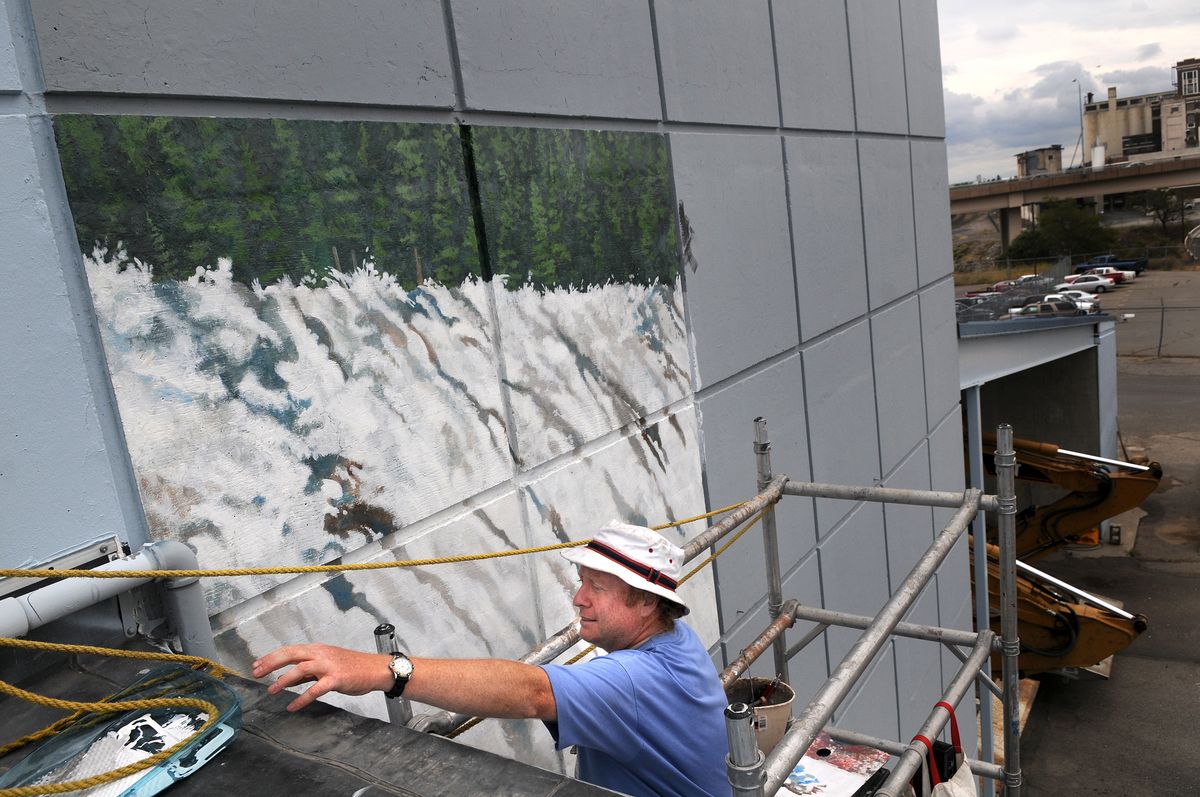Larger than life
Successful muralists capture city’s mood, history
Dave Quinn of Walls That Talk stops in front of his mural on the side of Empire Office Furniture at 1411 N. Monroe St. in Spokane. The mural depicts a trolley that ran on Monroe Street in the early 1900’s. (Photos by CHRISTOPHER ANDERSON (above) and Rajah Bose / The Spokesman-Review)
If you want to discover what a town is really all about, take a look at the hand-painted, sun-splashed murals scattered alongside its streets and corridors.
Artists have a way of capturing the mood of a place. When a muralist paints the side of a building, an underpass, a bridge piling, retaining wall or any other public structure, he is illustrating his passion for beautifying and documenting the area, while making art available to everyone who passes by.
The practice of mural making has been going on since the Stone Age. Some of the first known “murals,” so to speak, were painted on the walls of the Lascaux Cave in France, during what is considered to be the Aurignacian culture.
The Renaissance artists, circa 1500, including Michelangelo Buonarroti and Leonardo da Vinci, painted enormous, magnificent biblical frescoes on the walls and ceilings of cathedrals and chapels, which have been preserved for centuries.
In the West, after their Native American beginnings, murals became popularized by the early 20th century Mexican mural movement, with such renowned artists as Diego Rivera, Jose Orozco and David Siqueiros, who inspired the mural explosion in Los Angeles in the ’60s and ’70s.
In Spokane, our city’s murals speak for the nature of our surroundings. Images of our beautiful landscapes, waterways, flora and fauna, as well as our unique architecture and history hug the walls of public spaces.
At present, Spokane is host to some 50-plus murals, though many more have been painted over or have faded. City Arts Director Karen Mobley said that more than 30 of those have been produced in the last 10 years.
Two prolific Spokane muralists who share the same last name have painted the majority of our city’s newest murals: Tom Quinn and Dave Quinn. (Molly Quinn, the Spokesman-Review staff artist who produced the graphic on page D8, has also painted a public mural in Spokane – none of the three Quinns are related).
Tom Quinn is a painter, cartoonist, illustrator and art instructor, with degrees in art history from Gonzaga University and applied art at the Art Institute of Seattle.
A Spokane muralist for almost 20 years, he has been awarded much of the work through the Spokane Arts Commission.
His first outdoor public mural in Spokane was the “Marmots” on the corner of Division and Sprague, which is painted on the retaining wall under the train trestle and wraps around to the sunny Sprague street side. He completed the project in two weeks.
Other Tom Quinn murals include “Falco Peregrinus,” located near Vinegar Flats on Inland Empire Way, painted on the pilings of the I-90 and railroad bridges, and the street scene painted at Pacific and Cannon on the side of Tawney’s Dry Cleaners named “Browne’s Addition, circa 1925,” completed in 2004.
Tom Quinn’s most recent mural was completed last year. “The Flight of the Spokane Sun God” greets travelers on Concourse C in the Spokane International Airport.
He is just beginning the painting process on the new mural he’s been awarded on the front of the City of Spokane’s Sewer Maintenance Building on east Sprague.
The 35-by 105-foot main concrete wall section is composed of 3-by-3-foot squares, which work well for Tom Quinn’s transfer process. He draws thumbnail sketches and then a final drawing that works with the measurements of the wall. He then creates a scaled grid that mathematically translates to the larger squares on the wall (Normally, he has to measure the pre-determined grid lines and use a chalk snap line to place his grid onto the wall so he can transfer his finished drawing onto the large-scale wall, but since the squares are part of the architectural face of the building, he was able to skip that time-consuming step). He then paints his gridded image in increments, one square at a time.
The beauty of Tom Quinn’s murals – and there are more – is that he is able to achieve an artistic quality similar to his paintings on canvas.
“It’s just like handwriting,” he said. “You couldn’t change it if you wanted to.”
He expects to be finished with his new mural sometime this fall, when he will begin his next project in Cheney.
Dave Quinn is a commercial artist, painter, sign fabricator and entrepreneur who owns Walls that Talk Inc. He’s been producing notable signage, billboards and murals for most of his life.
Thirty years ago, he hand-painted 14-by-48-foot billboard signs for Don Rey Outdoor Advertising in Spokane, standing in shallow stalls from which he couldn’t step back to gain perspective.
“I’ve always been able to paint at a large scale,” he said. “The close confines didn’t bother me.”
Tom Quinn and Dave Quinn seem to be polar opposites in the way they produce murals. While Tom goes about his work in the way a traditional artist would, Dave has taken a commercial approach. Though the route he takes is different and more technical, his artistry leads him to an outstanding effect.
As a commercial artist, Dave has learned to peddle his wares. He finds his own clients and funding through his own creative means.
When Dave created The Onion’s logo, he did so simply for pleasure, inspired by a patron he’d seen there. Years later, The Onion’s owner asked him to make the sketch (a woman sitting on a hamburger) into a large-scale painted sign on the east exterior wall of his downtown restaurant.
Dave Quinn’s new public mural is a vintage ’20s streetcar scene at Empire Office Furniture, 1411 N. Monroe St., which he completed in less than a week. The 10-by-30-foot mural was situated at ground level, which sped up the process since no scaffold was necessary.
Dave has painted three other walls at the Empire Office Furniture site. One faces north and is a beautifully painted advertisement for the office furniture store. The other two walls face the courtyard between the store and the store owners’ neighboring house.
Bob and Michelle Tweedy, who have known Dave for years, requested a Tuscan vineyard scene on the west-facing wall that they view from their dining room. The courtyard’s south-facing wall is painted with an Italian castle, and can be glimpsed from the side street.
“My wife and I have done this because we love Spokane, and we love Monroe Street,” said Tweedy. “We wanted to capture some of the history.”
Dave’s technique starts with designing the artwork on the computer. He scans in logos, sketches and photographs, creating a finished design that will become the mural. He then scans in a photo or uses a digital image of the wall where the mural will be placed. His Corel computer drawing program helps him to place the image in the best position, and creates the new proportions for him.
He then projects the image onto paper in the full finished size. He uses an electro pounce machine or a hand pouncer to create a pattern of small pierced holes, similar to a seamstress’ pattern. He then tapes the paper into place on the wall, and stencils the pattern with colored charcoal.
Because he is such a skillful painter, Dave can complete the paintings rapidly. He uses oil based paint, and says that his work holds up for decades.
Of course, there are muralists who utilize parts of both techniques, or even paint freehand. Michelangelo used every technique in the book.
“It is hard work to make murals and it’s harder than it looks,” said Mobley. “The biggest challenge from my perspective is time. It takes time to plan, to raise money, and to actually get the work done.”
Mobley also has to maintain the existing murals, by organizing volunteers to do “paint outs.”
“Volunteers worked for 96 hours in May to repair murals between Sunset Highway and all the way to Havana,” she said.
Public Information Officer Jennifer De Ruwe acknowledged that less graffiti and vandalism occur within the presence of a mural.
“It’s related to the broken-window theory,” she said. “When you have a house with broken windows, or it’s run down, it encourages more bad behavior. The more graffiti you see, the more it increases. That’s why we work so fast to cover graffiti when we see it. When you see a mural, it’s recognized as art and culture, and it seems to be treated as such.”
Creating more murals is a community effort.
Mobley said, “I just visited Philadelphia, a city with more than 500 murals. Let’s be like them! It makes the city more attractive, more interesting, and most importantly it binds the people to the place.
“You will never think of an underpass the same way if you have stood in the traffic with a paintbrush in hand and felt the rush of people honking their horns and screaming their thank yous out the window,” said Mobley.
“People love the murals and they want their pictures to be a part of their world.”

